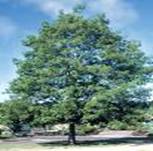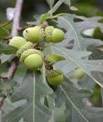| Kingdom | Plantae |
| Division | Magnoliophyta |
| Class | Magnoliopida |
| Order | Fagales |
| Family | Fagaceae |
| Genus | Quercus |
| Species | Q.alba |
| Binomial name | Quercus alba |
Other Common Names:
The other common names for the gospel tree are Oak, White oak and Tanners Bark.
History
The botanical name quercus comes from the Celt words quer (good) and cuez (tree), and the common name of chen (beautiful).

Description
Quercus alba, commonly known as White Oak, is a large deciduous shade tree renowned for its strength and long life. A slow grower, White Oak eventually attains heights of 50 to 80 feet and over 100 feet in the wild. The leaves are divided into several rounded lobes. The leaves usually turn red or brown in autumn, but depending on climate, site, and individual tree genetics, some trees are nearly always red, or even purple in autumn, others turn straight to a brown. Some brown, dead leaves may remain on the tree throughout winter until very early spring.


Range
Gospel tree is a native of United States. It is widely distributed in Eastern North America from Maine to Florida, west to Texas and Minnesota. Various parts of Texas can accommodate oak species of the Southeastern forests, Southwestern woodlands and mountains, and South-central plains.
Habitat
It grows best in well drained, moist, deep, and slightly acidic soils, and prefers full sun. White Oak is drought tolerant and has modest water needs. It is generally seen in dry woods, gravely ridges, sandy plains, rich uplands and moist bottoms. The best specimens are found in deep rich well-drained loamy soils.
Cultivation
The plant prefers medium loamy and heavy clay soils and can grow in heavy clay soil. The plant prefers acid, neutral and basic alkaline soils. It can grow in semi-shade light woodland or no shade. It requires dry or moist soil. The plant can tolerate strong winds but not maritime exposure. Seed - it quickly loses viability if it is allowed to dry out. It can be stored moist and cool over winter but is best sown as soon as it is ripe in an outdoor seed bed, though it must be protected from mice, squirrels etc. Small quantities of seed can be sown in deep pots in a cold frame. Plants produce a deep taproot and need to be planted out into their permanent positions as soon as possible, in fact seed sown in situ will produce the best trees. Trees should not be left in a nursery bed for more than 2 growing seasons without being moved or they will transplant very badly.
Flowering Season
The monoecious flowers of the white oak tree are in bloom from April to May.
Pests and Diseases
Potential diseases include oak wilt, anthracnose and oak leaf blister. Potential insects include scale, oak skeletonizer, leaf miner and lace bug.
Parts Used


The buds, young leaves, the acorns, the outer bark and the sapwood are the most commonly used parts of the tree for its commercial and medicinal purposes. Very common in many countries where it forms large forests.
Medicinal Applications

• Oak bark and galls are astringent and antiseptic.
• Oak bark provides tannin and as leather tanners seemed immune to tuberculosis, the bark was used for treatment of the disease.
• The white oak is the best for internal use. Infuse the inner bark or young leaf for douches and enemas.
• It is used for internal rectal problems, hemorrhoids, leukorrhea, menstrual irregularities, and bloody urine.
• It is also take internally as a tea and externally in fomentation, to shrink varicose veins.
• The tea brings down fevers, treats diarrhea, and makes a wash for sores.
• As a gargle, it treats mouth sores and sore throats. Being an astringent, it stops internal bleeding. Black oak (Q. tinctoria) and red oak (Q. rubra) can be
• Oak leaves are prepared in infusion for douches to treat vaginal infections.
• A tea of the buds is a valuable tonic for the liver; steep two teaspoons per cup of water for twenty minutes.
Commercial Applications


• White Oak is a hardwood tree commonly used in furniture construction, flooring, and wine barrels.
• White Oak is commonly grown as a shade tree or street tree, though if given sufficient room, it can also be planted as an ornamental lawn tree.
• The gall can be used as a rich source of tannin that can also be used as a dyestuff.
• The seed can be roasted and then eaten; its taste is something like a cross between sunflower seeds and popcorn.
• A mulch of the leaves repels slugs, grubs etc, though fresh leaves should not be used as these can inhibit plant growth.
• The bark is a rich source of tannin.
• It is used for cabinet making, construction, agricultural tools etc, and is also a good fuel.

The Ancient Greeks associated the oak with Zeus because of its strength and power, while the Romans associated it with Jupiter. The tradition of celebrating rituals in the shade of the oak tree continued after the introduction of Christianity, from which it got its English nickname" the prayer tree" or gospel tree. The Goths considered the oak a symbol of strength and triumph: the expression "strong as an oak" is deeply entrenched in popular memory.
Druids do not celebrate unless in the presence of an oak, yew, ash, or other sacred tree. Acorns gathered at night hold the most fertility powers. The Druids and priestesses listened to the rustling oak leaves and the wrens in the trees for divinitory messages. Burning oak leaves purifies the atmosphere. Represents the God. Use galls in chars. Acorns draw money, burn the wood for good health, energy, strength, power, protection, defense, money and business.
The Celts once considered the oak a holy symbol: on the sixth lunar day in December, the Druids harvested mistletoe with a gold billhook and announced the New Year with cries of: "To mistletoe, the new year." For many years, the acorn was used to produce flour for the peasants. Today, some Berber tribes still use it to make a nutritious gruel called racahout.Oak symbolized abundance, fertility, longevity, protection, and the ability to withstand the lightening blasts of spiritual awareness while remaning firmly rooted in the material. All parts of the tree are powerful protective charms, which bring healing. Magic wands are made of Oak Wood. A tree as long-lived and strong as the oak naturally offers magical protection. Oak Galls, known as Serpent's Eggs, were used in magical charms. Acorns bring fertility and acundance to any edeavor.